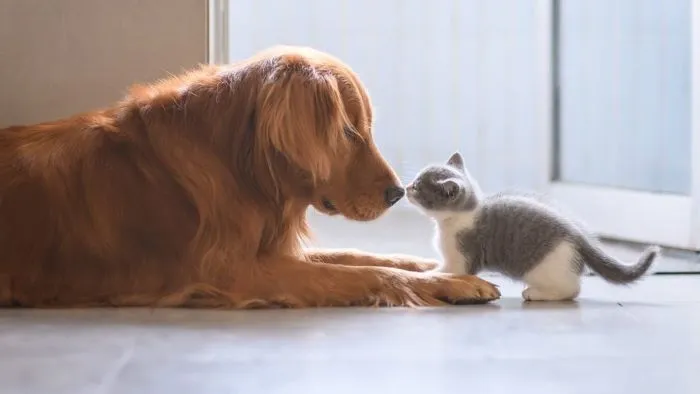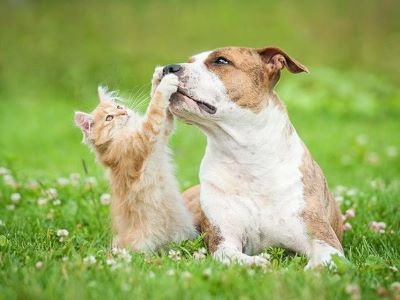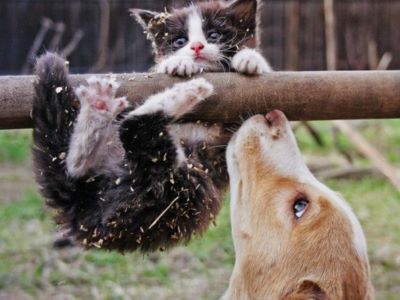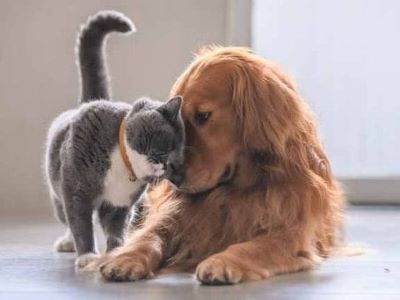We grew up watching shows that represented the love-and-hate relationship between cats and dogs, the cat always running for its life and the dog running to take the cat’s life, isn’t that how the animal kingdom works? But have you ever wondered why dogs chase cats?🐶🔁🐈⬛
Two curious creatures bonded by their instincts for chasing. Well, besides them getting the exercise there are some more reasons, let’s understand them in this article.

Why Do Dogs Chase Cats?
The urge to chase cats is deeply carved into a dog’s brain. Long before your lovely dogs and cats were domesticated, their wild ancestors surely chased each other for competition and territory.❌
Cats are quick to run their movement triggers dogs and they run after cats. Both cats and dogs act on their survival skills, one of them is a dog chasing the cat. However, not all dogs and cats have this relationship, many co-exist in harmony too!🤝
People get annoyed your dog means no harm to the cat, it’s their age of curiosity, Just a thrilling game! Let’s look into some other reasons for this behaviour:
Dog Reflex
“When a dog sees a cat darting across the room or garden, their primal instincts kick in. They can’t help but react to the quick, darting motion”, confirms the experts at Purina.

It's like a game of tag they just can't resist. In some cases, chasing might be a sign of asserting dominance or territorial control.🎮 Dogs, being pack animals, may see the need to establish order within their social group, even if that group includes cats.
Herding dogs like Border Collies chase moving things as part of their herding instinct. Sighthounds like Greyhounds use their speed and eyesight to chase prey.
Terriers were bred to hunt small animals, so they were prone to chasing cats. Guardian breeds like Rottweilers focus more on protection than chasing. Individual dogs also have variable chase aims based on their personality and training, not just breed.
Training and Playfulness
The extent to which dogs chase cats can also be influenced by their upbringing and socialisation. Proper training and early exposure to cats can help shape their behaviour towards cat companions.
In many cases, when dogs chase cats, it’s a form of play for them. Dogs have a strong social side and often see chasing as an exciting game. They might not intend to harm the cat; they simply want to engage in playful pursuit. 🛝🧸
Dogs might chase cats for attention. If a cat reacts by running away or making noise, it can trigger a dog’s interest and lead to more chasing behaviour.

How to Stop The Game of Chase? Tips!
Cats and Dogs just can not stop running behind each other, in multiple household situations the pet parents get confused, but do not worry we are here with the solution, keep reading:
Tip 1: Early Socialisation
The first step in stopping the chase is to ensure your dog and cat are introduced to each other at a young age, ideally when they’re puppies and kittens. This early socialisation can help them learn to coexist more peacefully. Training your dog is crucial.
Teaching commands like "leave it" "stay" and "no" can be incredibly effective in controlling their impulses. Consistent and positive reinforcement during training sessions can help your dog understand and obey these commands.
Tip 2: Leash and Play
When your dog and cat are together, especially at the beginning of their relationship, keep your dog on a leash. This allows you to have more control and prevent them from chasing the cat. Always watch their interactions to ensure safety.

Engage your dog in fun and interactive play to expend their energy. A tired dog is less likely to engage in chasing the cat. Provide toys and games that boost their minds and bodies, so they’re less interested in pursuing the cat.🧸🪀
Tip 3: Safe Environment
Create safe spaces for your cat where they can retreat if they feel threatened. High shelves, cat trees, or separate rooms can offer a sanctuary for your cat. This empowers them to escape when they need to.
Encourage positive associations between your dog and cat. When they are together, reward both with treats and praise for calm and peaceful behaviour. This can help create a positive bond between your cats and dogs.
Tip 4: Gradual Exposure
Slowly increase the amount of time your dog and cat spend together. Over time, as they become more familiar with each other’s presence, the chasing behaviour may naturally reduce.

Modifying behaviour takes time. Be patient✅ with both your dog and cat as they adapt to each other's company. Keep in mind that some dogs may always have a natural tendency to chase, but with the right training and environment, this behaviour can be managed.
If your dog’s chasing behaviour is persistent or problematic, it’s a good idea to talk to a vet or a trainer, they may help you in understanding your dog’s behaviour.
FAQs
❓Why Do Dogs Play With Cats?
One of the really common explanations for play between cats and dogs is that it almost acts as a mechanism for translation. Dogs and cats both entertain a complex series of behaviours intended for communication, but they do not match up between their species.
❓Why Do Dogs Chase Cats?
Dogs chase cats because they have a strong chase instinct and that movement can trigger this instinct. However, there are instances of dogs living with cats for years without chasing them before suddenly developing this instinct.
❓How Do I Know if My Dog Likes My Cat?
The first thing you want to do is pay attention to the body language of both animals. Ideally, the body language of both pets will be loose and relaxed. In particular, watch how they look at each other. As you watch the dog, notice whether he can look at the cat and then look away.
❓Do Cats Remember Their Names?
Cats do recognize their own names (as long as the name is tied to positive reinforcement). Cats can also identify and remember vocal patterns. Clicker training can help cats understand their name and associate it with a positive experience (treats, toys, attention).
Summary
In conclusion “Why Do Dogs Chase Cats?” Chasing a cat is a thrilling age-old game for a dog, they don’t mean any harm. It is their natural behaviour but you can stop this with the help of a vet🧑⚕️ or a trainer.
You can provide a safe and secure environment for both your dog and cat. You must introduce them gradually to each other and be patient, with time and consistency they will learn to coexist peacefully. Till then you can enjoy their funny chasing!🐶🔁🐈⬛



